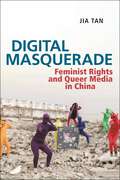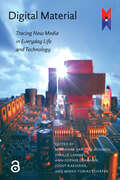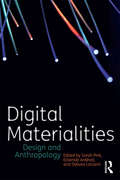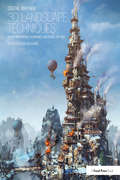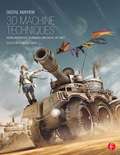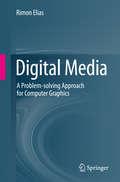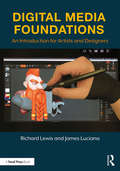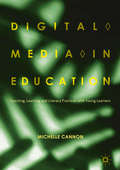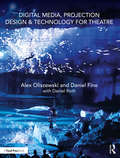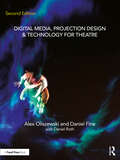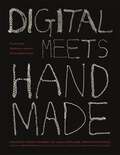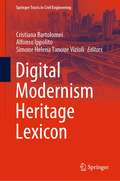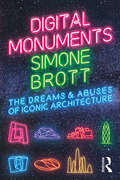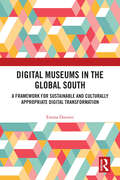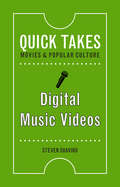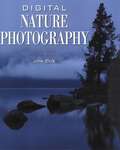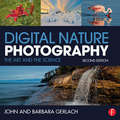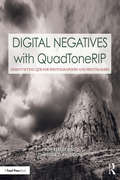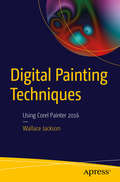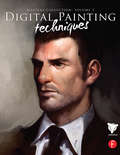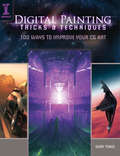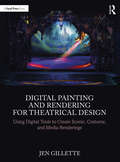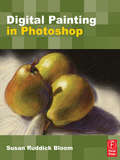- Table View
- List View
Digital Masquerade: Feminist Rights and Queer Media in China (Postmillennial Pop #30)
by Jia TanCharts a new wave of feminist and queer media activism in post-millennial ChinaDigital Masquerade offers a trenchant and singular analysis of the convergence of digital media, feminist and queer culture, and rights consciousness in China. Jia Tan examines the formation of what she calls “rights feminism,” or the emergence of rights consciousness in Chinese feminist formations, as well as queer activism and rights advocacy. Expanding on feminist and queer theory of masquerade, she develops the notion of “digital masquerade” to theorize the co-constitutive role of digital technology as assemblage and entanglement in the articulation of feminism, queerness, and rights. Drawing from interviews with various feminist and queer media practitioners, participant observation at community events, and detailed analyses of a variety of media forms such as social media, electronic journals, digital filmmaking, film festivals, and dating app videos, Jia Tan captures the feminist, queer, and rights articulations that are simultaneously disruptive of and conditioned by state censorship, technological affordances, and dominant social norms.
Digital Material: Tracing New Media in Everyday Life and Technology (MediaMatters)
by Sybille Lammes Ann-Sophie Lehmann Mirko Tobias Schäfer van den Boomen, Marianne Joost RaessensThree decades of societal and cultural alignment of new media have yielded a host of innovations, trials, and problems, accompanied by versatile popular and academic discourse. New Media Studies crystallized internationally into an established academic discipline, and this begs the question: where do we stand now? Which new questions are emerging now that new media are being taken for granted, and which riddles are still unsolved? Is contemporary digital culture indeed all about 'you', the participating user, or do we still not really understand the digital machinery and how this constitutes us as 'you'? The contributors to the present book, all employed in teaching and researching new media and digital culture, assembled their 'digital material' into an anthology, covering issues ranging from desktop metaphors to Web 2.0 ecosystems, from touch screens to blogging and e-learning, from role-playing games and cybergothic music to wireless dreams. Together the contributions provide a showcase of current research in the field, from what may be called a 'digital-materialist' perspective. A compelling study of the often controversial role and meaning of the new media and digital cultures in contemporary society.
Digital Materialities: Design and Anthropology
by Sarah Pink Elisenda Ardèvol Débora LanzeniAs the distinction between the digital and the material world becomes increasingly blurred, the ways in which we think about design are also shifting and evolving. How can the human, digital and material be brought together to intervene in the world? What constitutes our digital-material environments? How can we engage with digital technologies to make sustainable, healthy and meaningful decisions, both now and in the future? Digital Materialities presents twelve chapters by scholars and practitioners working at the intersection between design and digital research in the UK, Spain, Australia and the USA. By incorporating in-depth understandings of the digital-material world from both the social sciences and design, the book considers how this combined knowledge might advance our capacity to design for the future. Divided into three parts, the focus of the book moves from the theoretical to the practical: how different digital materialities are imagined and emerge, through software emulation, urban sensors and smart homes; how new digital designs are sparked through collaborations between social scientists and designers; and finally, how digital design emerges from the insider work of everyday designers. A fascinating, ground-breaking book for students and scholars of digital anthropology, media and communication, and anyone interested in the future of digital design.
Digital Mayhem 3D Landscape Techniques: Where Inspiration, Techniques and Digital Art meet
by Duncan EvansCompiled by Duncan Evans, founder and inspiration behind 3DArtist Magazine. The Masters at Work titles will offer digital inspiration with hands-on insight and techniques from professional digital artists. More than just a gallery book - each artist has written a breakdown overview, with supporting imagery of how they made their piece of work. Start your mentorship into the world of digital art today with some of the greatest digital artists in the world and delve into professional techiques. We are asking you to comment on the series itself and then the first title in the series. The first title in the series will focus on 3D Landscapes. You will be able to develop your landscape and background skills beyond the variety of free online tutorials and apply the most up to date techniques, like colour and contrast enhancements, sharpening, composition, lighting and more! Expand your digital canvas to include a variety of new software tools with Masters at Work: 3D Landscapes. There will be a supporting website with source files, downloadable content and artist tutorials, demonstrating key techniques of some of the greatest digital artists.
Digital Mayhem 3D Machine Techniques: Where Inspiration, Techniques and Digital Art meet
by Duncan EvansFrom Icy Tundras to Desert savannahs, master the art of landscape and environment design for 2D and 3D digital content. Make it rain, shower your digital scene with a snow storm or develop a believable urban scene with a critical eye for modeling, lighting and composition. Move beyond the limitations of gallery style coffee table books with Digital Mayhem: 3D Landscapes-offering leading professional techniques, groundbreaking inspiration, and artistic mastery from some of the greatest digital artists. More than just a gallery book - each artist has written a breakdown overview, with supporting imagery of how they made their piece of work. Compiled by Duncan Evans, founder and inspiration behind 3DArtist Magazine, start your mentorship into the world of digital art today with some of the greatest digital artists in the world! Develop your landscape and background skills beyond the variety of free online tutorials and apply the most up to date techniques, like colour and contrast enhancements, sharpening, composition, lighting and more! Expand your digital canvas to include a variety of software techniques, tools and workflows featuring Photoshop, Painter, Maya and 3ds Max examples. A source of inspiration for digital artists everywhere: more than 50 artists and 700 stunning color images are showcased with an in-depth companion website that includes professional source files and further technique based skills development.
Digital Media
by Rimon EliasFocusing on the computer graphics required to create digital media this book discusses the concepts and provides hundreds of solved examples and unsolved problems for practice. Pseudo codes are included where appropriate but these coding examples do not rely on specific languages. The aim is to get readers to understand the ideas and how concepts and algorithms work, through practicing numeric examples. Topics covered include: 2D Graphics 3D Solid Modelling Mapping Techniques Transformations in 2D and 3D Space Illuminations, Lighting and Shading Ideal as an upper level undergraduate text, Digital Media - A Problem-solving Approach for Computer Graphic, approaches the field at a conceptual level thus no programming experience is required, just a basic knowledge of mathematics and linear algebra.
Digital Media Foundations: An Introduction for Artists and Designers
by Richard Lewis James LucianaThis book is a creative and practical introduction to the field of digital media for future designers, artists, and media professionals. It addresses the evolution of the field, its connections with traditional media, up-to-date developments, and possibilities for future directions. Logically organized and thoughtfully illustrated, it provides a welcoming guide to this emerging discipline. Describing each medium in detail, chapters trace their history, evolution, and potential applications. The book also explains important, relevant technologies—such as digitizing tablets, cloud storage, and 3-D printers—as well as new and emerging media like augmented and virtual reality. With a focus on concepts and creative possibilities, the text’s software-neutral exercises provide hands-on experiences with each of the media. The book also examines legal, ethical, and technical issues in digital media, explores career possibilities, and features profiles of pioneers and digital media professionals. Digital Media Foundations is an ideal resource for students, new professionals, and instructors involved in fields of graphic and visual arts, design, and the history of art and design.
Digital Media in Education: Teaching, Learning and Literacy Practices with Young Learners
by Michelle CannonThis book argues for dynamic and relevant school experiences for primary and early secondary learners that embed digital media production. It proposes a vision of literacy that combines new technologies with multiple modes of meaning-making. Drawing on theories related to cultural studies, media literacy, anthropology, and creativity, the author explores learning strategies with digital media based on an empowering, values-driven framework. The book advances innovative teaching methods, critiquing educational ‘reforms’ that marginalise media and fail to engage with the complex tensions and textures of modern pedagogy. Positioning film and media-making as vital practices in schools that nurture the skills, dispositions and competencies of modern literacy, the model foregrounds connections between human agency, cognition, and creative practice. This innovative book will appeal to students and scholars of creativity, digital media production, primary education and literacy.
Digital Media, Projection Design, and Technology for Theatre
by Alex Oliszewski Daniel Fine Daniel RothDigital Media, Projection Design, and Technology for Theatre covers the foundational skills, best practices, and real-world considerations of integrating digital media and projections into theatre. The authors, professional designers and university professors of digital media in live performance, provide readers with a narrative overview of the professional field, including current industry standards and expectations for digital media/projection design, its related technologies and techniques. The book offers a practical taxonomy of what digital media is and how we create meaning through its use on the theatrical stage. The book outlines the digital media/projection designer’s workflow into nine unique phases. From the very first steps of landing the job, to reading and analyzing the script and creating content, all the way through to opening night and archiving a design. Detailed analysis, tips, case studies, and best practices for crafting a practical schedule and budget, to rehearsing with digital media, working with actors and directors, to creating a unified design for the stage with lighting, set, sound, costumes, and props is discussed. The fundamentals of content creation, detailing the basic building blocks of creating and executing digital content within a design is offered in context of the most commonly used content creation methods, including: photography and still images, video, animation, real-time effects, generative art, data, and interactive digital media. Standard professional industry equipment, including media servers, projectors, projection surfaces, emissive displays, cameras, sensors, etc. is detailed. The book also offers a breakdown of all key related technical tasks, such as converging, warping, and blending projectors, to calculating surface brightness/luminance, screen size and throw distance, to using masks, warping content and projection mapping, making this a complete guide to digital media and projection design today. An eResource page offers sample assets and interviews that link to current and relevant work of leading projection designers.
Digital Media, Projection Design, and Technology for Theatre
by Alex Oliszewski Daniel Fine Daniel RothDigital Media, Projection Design, & Technology for Theatre, Second Edition comprehensively details the integration of digital media and projections in theatre and live performance, providing foundational skills, best practices, and real-world applications and considerations.The book provides readers with an overview of the professional field, including current industry standards and workflows for digital media/projection design, its related aesthetics, techniques, and technologies. A practical taxonomy of digital media and how we create meaning through its use on the theatrical stage along with the essential tools and techniques for creating and executing digital content are covered. Readers are introduced to the fundamentals of creating and executing digital content, including photography and still images, generative AI, video, animation, real-time effects, generative art, data, and interactive digital media. The book also details the types and use of industry-standard equipment, including media servers, projectors, projection surfaces, emissive displays, cameras, sensors, and more. It guides readers through technical tasks, such as programming media servers; converging and blending projectors; projection mapping; calculating surface brightness/luminance, screen size, and throw distance; and more, making this a complete guide to digital media and projection design today. The second edition is updated with new content throughout and two new chapters addressing the latest technologies and trends in virtual performance, motion capture, generative AI, and VR/AR. Ten new case studies from diverse practitioners have been added, and the book is restructured with shorter chapters for easier navigation and reference.This book serves well as a main or supplemental textbook for courses in projection design, theatre, and digital media design. It is also useful for emerging practitioners.Sample assets and interviews with leading projection designers are available for download at www.routledge.com/9781032302157.
Digital Meets Handmade: Jewelry Design, Manufacture, and Art in the Twenty-First Century
by Wendy Yothers Alba Cappellieri Susanna Testa Troy RichardsOver the past twenty years, a seismic shift has occurred in jewelry design and manufacturing. As digital design, digital model-making, and prototyping have elbowed their way into common practice, they have proven themselves to be both invaluable and disruptive to the jewelry profession. Bringing together the perspectives of artisans, educators, students, mavens from the realm of fine jewelry, renegades from the Wild West of the maker movement, and innovators from the digital engineering sector, Digital Meets Handmade addresses a wide range of topics in jewelry design, delving into the broad conversation around how digital technologies and virtuoso handcraft can coalesce in jewelry as wearable art. While one might expect a collision of cultures—"fine jewelry" craftspeople versus digital engineers—the result instead is a dazzling array of critical thinking, with stunning illustrations that foretell the future of jewelry.
Digital Memory and the Archive (Electronic Mediations #39)
by Wolfgang ErnstIn the popular imagination, archives are remote, largely obsolete institutions: either antiquated, inevitably dusty libraries or sinister repositories of personal secrets maintained by police states. Yet the archive is now a ubiquitous feature of digital life. Rather than being deleted, e-mails and other computer files are archived. Media software and cloud storage allow for the instantaneous cataloging and preservation of data, from music, photographs, and videos to personal information gathered by social media sites.In this digital landscape, the archival-oriented media theories of Wolfgang Ernst are particularly relevant. Digital Memory and the Archive, the first English-language collection of the German media theorist&’s work, brings together essays that present Ernst&’s controversial materialist approach to media theory and history. His insights are central to the emerging field of media archaeology, which uncovers the role of specific technologies and mechanisms, rather than content, in shaping contemporary culture and society.Ernst&’s interrelated ideas on the archive, machine time and microtemporality, and the new regimes of memory offer a new perspective on both current digital culture and the infrastructure of media historical knowledge. For Ernst, different forms of media systems—from library catalogs to sound recordings—have influenced the content and understanding of the archive and other institutions of memory. At the same time, digital archiving has become a contested site that is highly resistant to curation, thus complicating the creation and preservation of cultural memory and history.
Digital Modernism Heritage Lexicon (Springer Tracts in Civil Engineering)
by Cristiana Bartolomei Alfonso Ippolito Simone Helena Tanoue VizioliThe book investigates the theme of Modernism (1920-1960 and its epigones) as an integral part of tangible and intangible cultural heritage which contains the result of a whole range of disciplines whose aim is to identify, document and preserve the memory of the past and the value of the future. Including several chapters, it contains research results relating to cultural heritage, more specifically Modernism, and current digital technologies. This makes it possible to record and evaluate the changes that both undergo: the first one, from a material point of view, the second one from the research point of view, which integrates the traditional approach with an innovative one. The purpose of the publication is to show the most recent studies on the modernist lexicon 100 years after its birth, moving through different fields of cultural heritage: from different forms of art to architecture, from design to engineering, from literature to history, representation and restoration. The book appeals to scholars and professionals who are involved in the process of understanding, reading and comprehension the transformation that the places have undergone within the period under examination. It will certainly foster the international exchange of knowledge that characterized Modernism
Digital Monuments: The Dreams and Abuses of Iconic Architecture
by Simone BrottDigital Monuments radically explodes "iconic architecture" of the new millennium and its hijacking of the public imagination via the digital image. Hallucinatory constructions such as Rem Koolhaas’s CCTV headquarters in Beijing, Frank Gehry’s Guggenheim Museum in Bilbao and Zaha Hadid’s Performing Arts Centre in Abu Dhabi are all introduced to the world by immortal digital imagery that floods the internet—yet comes to haunt the actualised buildings. Like holograms, these "digital monuments," which violently push physics and engineering to their limits, flicker eerily between the real and the unreal—invoking fantasies of omnipotence, immortality and utopian cities. But this experience of iconic architecture as a digital dream on the ground conceals from the urban spectator the social reality of the buildings and the rigidity of their ideology. In 18 micro-essays, Digital Monuments exposes the stereotypes of iconic architecture while depicting the savagery of the industry, from the Greek and Spanish crises triggered by financialised iconic development to mass labour-deaths on construction sites in the UAE.
Digital Museums in the Global South: A Framework for Sustainable and Culturally Appropriate Digital Transformation
by Emma DuesterThis book focuses on digital museums in the context of Vietnam and contributes to global discussions on the development of digital museum offerings needed to meet audience demands, requirements for sustainable digitisation methods for cultural heritage, demands for the development of intellectual property protection for the digital environment, and shows ways for national governments to support digital museums.Duester provides insight into museums in part of the Global South, where infrastructure funding and technical and human resource constraints impact the take-up and display of digital content. With on-the-ground research from three Vietnamese museums, Duester argues for a museum framework that is sustainable, ethical, and culturally appropriate. The Vietnamese government’s strategy for digitalisation of culture, heritage, and museums is assessed, and the book includes a list of recommendations on sustainable digitisation methods, intellectual property protection measures for the digital environment, management, phygital business models, and new digital revenue streams.The volume will benefit scholars involved in the cultural and creative industries, as well as museum professionals and cultural policymakers who will value the book’s assessment of international standards, treaties, and conventions on copyright law and how they apply to museums, as well as the recommendations listed above.
Digital Music Learning Resources: From Research to Educational Practice (SpringerBriefs in Education)
by Marcella Mandanici Simone Spagnol Luca Andrea Ludovico Adriano Baratè Federico AvanziniThis book offers an overview of the complex world of digital materials for music education and of their possible use in the everyday practice of music teachers. It presents a multidimensional taxonomy of digital materials for music education. Through the taxonomy it is possible to derive a clear framework of the whole field and to perform analysis of the state of art. The book shows the use of this flexible and powerful knowledge tool for reviewing the digital materials in the various domains and dimentions. The book provides researchers and designers with an overview of what has already been designed, proposed and tested in the field. It also offers music teachers a wider perspective of the possibilities connected to current technologies in the field of music education, and it suggests possible interrelationships between research and music education practices.
Digital Music Videos
by Steven ShaviroMusic videos today sample and rework a century’s worth of movies and other pop culture artifacts to offer a plethora of visions and sounds that we have never encountered before. As these videos have proliferated online, they have become more widely accessible than ever before. In Digital Music Videos, Steven Shaviro examines the ways that music videos interact with and change older media like movies and gallery art; the use of technologies like compositing, motion control, morphing software, and other digital special effects in order to create a new organization of time and space; how artists use music videos to project their personas; and how less well known musicians use music videos to extend their range and attract attention. Surveying a wide range of music videos, Shaviro highlights some of their most striking innovations while illustrating how these videos are creating a whole new digital world for the music industry.
Digital Nature Photography
by Jon CoxDigital Nature Photography is the definitive how-to book on photographing nature with a digital camera. Focusing primarily on the art of taking the picture in the field--rather than just manipulating the image after it has been shot--this comprehensive guide is geared to the nature photographer who is fairly new to the world of digital cameras. Packed with step-by-step directions and resplendent full-color examples from the author's own body of work, readers will receive hands-on practice with lighting, composition, landscapes, sunrises, sunsets, animal portraits, close-ups, manipulating and storing images, and much more. The essential reference for every level of photographer, Digital Nature Photography guides the reader through a magnificent and unique visual experience into the natural world.
Digital Nature Photography: The Art and the Science
by John and GerlachIdentifying a beautiful image in nature is easy, but capturing it is often challenging. To truly seize the essence of a photograph shot out of the studio and in the world requires an artistic eye and impeccable set of photographic techniques. John and Barbara Gerlach have been teaching photographers how to master the craft of photographing nature and the outdoors through their workshops and best-selling books for more than twenty years. Now, equipped with brand new images to share and skills to teach, this celebrated photo team is sharing their latest lessons in the second edition of Digital Nature Photography. Notable revisions in this new edition include introducing the concepts of focus stacking and HDR, as well as expanded discussions of multiple exposure, wireless flash, RGB histograms, live view, shutter priority with auto ISO, hand-held shooting techniques, and the author’s equipment selections. The inspiring imagery in this book covers a broader range of subjects than before including ghost towns, the night sky, animals, and sports, in addition to the classic nature photographs we expect from this very talented author team. This book is a comprehensive guide to one of the broadest subjects in photography, explained and dymystified by two respected masters.
Digital Negatives with QuadToneRIP: Demystifying QTR for Photographers and Printmakers (Contemporary Practices in Alternative Process Photography)
by Christina Z Anderson Ron ReederDigital Negatives with QuadToneRIP is a text that fully explores how the QuadToneRIP printer driver can be used to make expert digital negatives. The book takes a comprehensive, Òunder-the-hoodÓ look at how Roy Harrington’s QTR printer driver can be adapted for use by artists in several different creative practice areas. The text is written from the Mac/Photoshop point of view. The book is divided into three parts. Part One is a step-by-step how-to section that will appeal to both beginning and more advanced practitioners. Part One includes quickstart guides or summary sheets for beginning students who want to jump into using QTR before understanding all of its functional components. Part Two addresses dimroom, darkroom, and printmaking practices, walking the reader through brief workflows from negative to print for lithium palladium, gum bichromate, cyanotype, salted paper, kallitype, silver gelatin and polymer photogravure, with a sample profile for each. It also includes an introduction to a new software iteration of QTR: QuickCurve-DN (QCDN). Part Three is devoted to contemporary practitioners who explain how they use QTR in their creative practice. The book includes: A list of supplies and software needed A summary QTR glossary with a simple explanation of how each function works A sample walk-through to create a QTR profile from start to finish How to linearize profiles with simple to more exacting tools A visual guide to modifying functions Quickstart guides for many of the workflows Instructions for crafting monochrome, duotone, tricolor, and quadcolor negatives Instructions for using QTR to print silver gelatin in the darkroom Instructions for using QTR to print alternative processes in the dimroom Instructions for using QTR to print polymer photogravure in the printmaking room Introductory chapter to QuickCurve-DN software Troubleshooting common QTR problems Generic starter profiles for processes discussed Contemporary artists: their work and QTR process. Learning how to craft expert digital negatives can be a bit overwhelming at the outset. Digital Negatives with QuadToneRIP makes the process as user-friendly as possible. Like other books in the series, Digital Negatives with QuadToneRIP is thoroughly comprehensive, accessible to different levels of learner, and illustrative of the contemporary arts.
Digital Painting Techniques
by Wallace JacksonLearn the foundational concepts of vector graphics and raster imaging, including what new media formats are best for use with Android Studio, Java and JavaFX, iOS, Kindle and HTML5, as well as key factors regarding the data footprint optimization work process, and why data footprint optimization is important. Digital Painting Techniques covers concepts central to digital painting using the Inkscape 0. 91 open source software package as well as the Corel Painter 2016 professional digital painting software package. What you'll learn The terminology of digital painting What comprises a digital painting 2D modeling and rendering pipeline Concepts and principles behind digital painting content production How to install and utilize 64-bit Inkscape 0. 91 and Corel Painter 2016 Concepts behind curves, strokes, fills, patterns, rendering and physics Digital painting data formats and data footprint optimization Who this book is for Digital artists, illustrators, painters, user interface designers, digital signage content developers, e-learning content creators, ebook cover artists, album cover artists Secondary: Android developers, iOS developers, website developers, Flash developers, multimedia producers, rich internet application (RIA) programmers, game designers, teachers, educators. Table of Contents Chapter 1 Digital Painting Software: Corel Painter and Inkscape Chapter 2 The Terminology of Digital Painting: Vector and Raster Chapter 3 The Foundation of Digital Painting: Canvas and Brush Chapter 4 The Hardware of Digital Painting: Tablet and Stylus Chapter 5 The Brushes of Digital Painting: Patterns and Paths Chapter 6 The Depth of Digital Painting: Using Gradients Chapter 7 The Imagery of Digital Painting: Using Patterns Chapter 8 The Rendering of Digital Painting: Data Formats Chapter 9 The Vectorization of Digital Imagery: Creating Shapes Chapter 10 The Algorithms of Digital Painting: Plug-In Filters Chapter 11 The Customization of Digital Painting: Brush Design Chapter 12 The Airbrush of Digital Painting: Physics Engines Chapter 13 The Compositing of Digital Painting: Using Layers Chapter 14 The Flexibility of Digital Painting: Image Editing Chapter 15 The Automation of Digital Painting: Programming Chapter 16 Publish Digital Paintings: Content Delivery Platforms
Digital Painting Techniques: Masters Collection
by 3dtotal.ComDiscover the tips, tricks and techniques that really work for concept artists, matte painters and animators. Compiled by the team at 3dtotal.com, Digital Painting Techniques, Volume 1 offers digital inspiration with hands-on insight and techniques from professional digital artists. More than just a gallery book - within Digital Painting Techniques each artist has written a breakdown overview, with supporting imagery of how they made their piece of work. Beginner and intermediate digital artists will be inspired by the gallery style collection of the finest examples of digital painting from world renowned digital artists. Start your mentorship into the world of digital painting today with some of the greatest digital artists in the world and delve into professional digital painting techiques, such as speed painting, custom brush creation and matte painting. Develop your digital painting skills beyond the variety of free online digital painting tutorials and apply the most up to date techniques to your digital canvas with Digital Painting Techniques for Animators.
Digital Painting Tricks & Techniques: 100 Ways to Improve Your CG Art
by Gary TongeThis book provides all the advice artists need to transform their digital painting--from brush, lighting and color basics to special effects, working with layers, and speed and matte painting. The 100+ expert tricks provide quick and easy solutions to all aspects of digital painting through clear instructions, step-by-step demonstrations and breathtaking annotated art. The book is divided into core elements of digital painting providing beginner, improver and advanced techniques to ensure progression and relevance to all skill levels, making it ideal for beginners and essential for more experienced digital painters. This is the ultimate tool to help emerging CG artists get started with digital painting, and help advanced CG artists improve their digital painting techniques.
Digital Painting and Rendering for Theatrical Design: Using Digital Tools to Create Scenic, Costume, and Media Renderings
by Jen GilletteDigital Painting and Rendering for Theatrical Design explores the tools and techniques for creating dazzling, atmospheric, and evocative digitally painted renderings for scenic, costume, and projection/integrated media design. By focusing on technique rather than the structure of a particular software, this book trains theatrical designers to think and paint digitally, regardless of the software or hardware they choose. The text begins with the construction of the artist’s physical and digital workspace, then delves into an explanation of tool functionality, technique-building exercises, and examples from professional theatrical designers to help contextualize the concepts presented. Each chapter gradually progresses in complexity through skill-building exercises and advanced tool functionality, covering concepts like brush construction, various forms of masking, and layer interaction. The book explores various methods of constructing a digital rendering, including producing digital paintings that look like traditional media and photo bashing – the practice of using extant photographs to create a collaged image. Concepts are contextualized throughout the text using illustrations, quotes, and interviews with working professional designers. This beautifully illustrated guide is written for professional theatrical artists, students of theatrical design, and other visual artists looking to broaden their digital painting skillset.
Digital Painting in Photoshop
by Susan Ruddick BloomHave you ever considered using Photoshop to create fine art?Photoshop is usually used for enhancing photos, but this extremely powerful software package is capable of so much more. Every feature, from brushes to background, can be customised and optimised for artistic effect. With a little guidance from a pro, your photoshop results can go from competent retouching of images to visually stunning re-interpretations of them, turning everyday pictures into breathtaking works of art.In this beautiful and inspiring book, acclaimed artist, author and lecturer Susan Bloom shows you how to do just that. Starting with the fundamentals: creating your own artistic brushes and textured papers virtually, she goes on to demonstrate how to create a variety of classic artistic styles in Photoshop, with chapters on watercolours, pastels, charcoal and oil. Further chapters cover illustration techniques in photoshop, and using third-party software to create painterly effects.While the results are highly polished and realistic, this is not a book written specifically for artists. The techniques are aimed squarely at the Photoshop user looking to broaden their pallette, with emphasis on altering photographs to create artwork, rather than creating artwork from scratch. Beautifully written, clearly laid out, and guaranteeing inspiring results, this book is a must-have for every Photoshop user.
